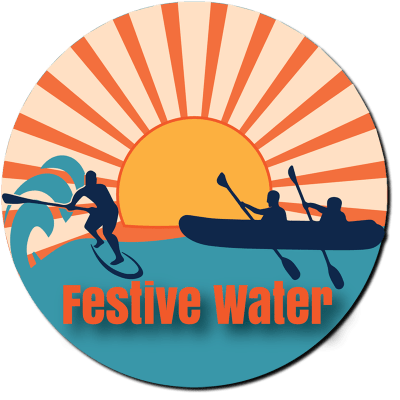If you are interested in whitewater kayaking, our team can help you weigh some important options. There are a variety of factors to consider when buying your next whitewater kayak.
Even though whitewater kayaking is a niche sport and a small industry, the number of kayak choices on the market can be overwhelming. Fortunately, Festive Water carries some of the best whitewater kayak manufacturers in the sport. However, some boats are better suited for beginners than others, and choosing the right kayak will make starting out much more enjoyable and help you improve your whitewater skills more efficiently.
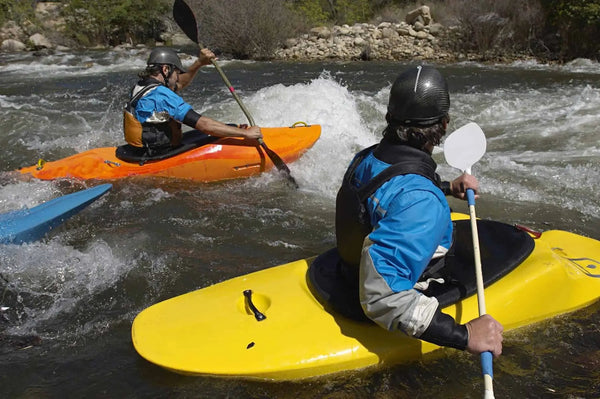
In this post, we will cover the following so you can decide what kayak is best for you:
- Common kayak terms
- Kayak sizing
- Whitewater kayak designs/types
- Types of whitewater
- Your experience level and goals
- What kayak is best for you
- Must have accessories and gear
Common terms to understand when buying a kayak
Outfitting
Outfitting is the equipment inside the cockpit of the kayak that holds you in, makes you more comfortable, and keeps you in control of your boat. The seat, back band, thigh hooks, and foot braces (or bulkhead) are the main points that hold you into your kayak. New kayaks will come with a variety of pads to help you make your outfitting fit you well.
Outfitting your kayak takes patience, time, and a bit of trial and error, but at the end of the day, you reap the rewards. Once you have it dialed in, spending all day in your boat will be a pleasure, not a pain.
Edges
Edges are where the kayak transitions from the bottom of the hull to the side. Every whitewater kayak has edges of some sort. Some of them are so pronounced that you can reach your hands under your kayak and feel big grooves running parallel along the length of the hull. Some kayaks have less aggressive edges. These edges will feel like rounded corners on the hull of your kayak, and are sometimes so round that the kayak feels like it has no edges at all. Soft edges are more curved and forgiving. Sharp edges allow you to carve across current better, but are less forgiving and allow you to flip easier if your technique is off.
The purpose of edges on a whitewater kayak is to provide the boat with a flat, stable hull to surf waves and glide across the water on. Edges are responsible for making whitewater kayaks maneuverable and easy to turn in whitewater, as well as making it possible to go in and out of different river currents without capsizing.
Rocker
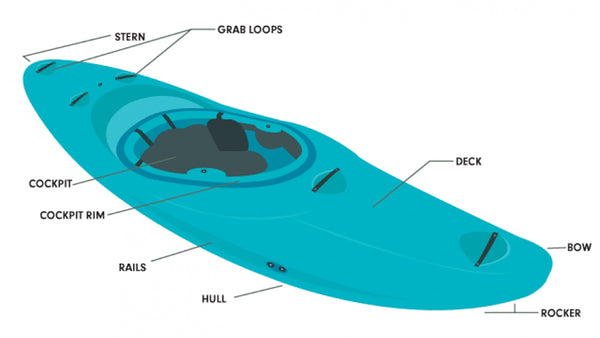
Rocker is the degree of curvature in the hull from bow to stern. A kayak with more rocker is easier to turn and maneuver but harder to paddle in a straight line. In general, the greater the amount of rocker, the easier you can turn the boa, which can be critical when paddling on whitewater. A flat paddle craft (no rocker) is generally more stable and buoyant but tends to be difficult to turn. With longer, narrower, and flatter kayaks, the stroke-to-glide efficiency typically increases.
Hull type
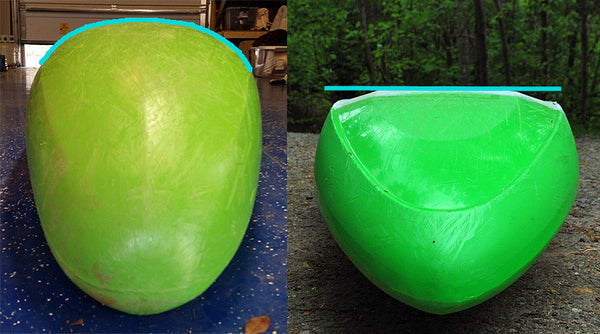
Whitewater kayaks have one of three hull types: planing hulls, displacement hulls, or semi-displacement hulls.
Planing hull kayak
Planing hulls have a flat surface on the bottom of the boat, commonly seen on playboats. The flat bottom of a planing hull will plow through the water at low speeds, but at higher speeds—such as when shooting down the face of a wave—it’ll skim on the surface and allow for spin.
Displacement hull kayak
Displacement hulls are rounded, like the bottom of a banana, and push the water aside as they travel through it. You’ll see this design on most creek boats. The continuous curve of a displacement hull allows the paddler to track and edge easier, but its primary stability might feel lacking in comparison to a planing hull.
Semi-displacement hull kayak
The semi-displacement hull, a more recent design, is a combination of the two, with a slightly flat hull transitioning into a curve. Semi-displacement hulls are a compromise of sorts, offering some of the stability of a planing hull and a portion of the tracking of a displacement hull.
Kayak Sizing
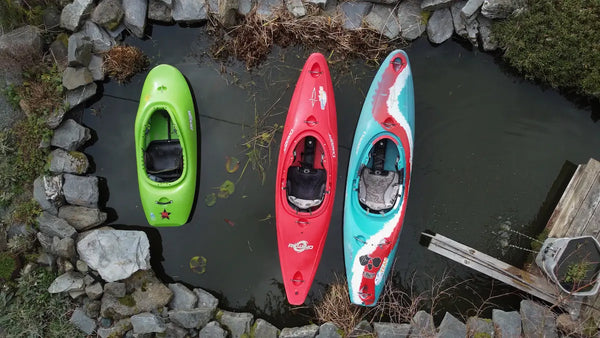
Most whitewater kayaks come in different sizes of the same design. Those sizes are defined by the manufacturer, sometimes generally (small, medium, or large) or more precisely using volume like 76, 86, or 96 (volume in gallons). Some kayaks are one size fits most, and rely on your own personal outfitting to customize the fit.
Volume
The volume of a kayak can give you insight into the size of the boat. Some manufacturers use volume as a size label for their kayaks. While comparing volume is helpful when determining the relative size of a boat, often the way the volume is distributed can have more of an impact.
Weight Range
When you look at the specs for a kayak, the manufacturer always provides a weight range so paddlers can choose the right size based on their weight. Be sure to double check the weight range of a kayak you plan on purchasing.
Length and width
Kayak manufacturers publish a width and and length for all kayaks. Wider kayaks are often more stable than narrower kayaks, and shorter kayaks are easier to turn but also slower than longer kayaks.
Types of whitewater kayaks
Historically, whitewater kayaks have been split into three categories:
- River Runners
- Creek Boats
- Freestyle kayaks
- Half-slice kayaks
- Crossover kayaks
- Sit-on-top kayaks
River Runners
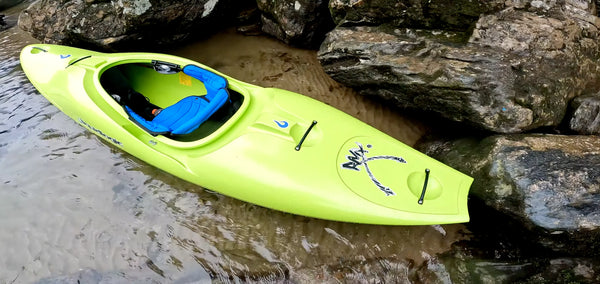
River running kayaks are for people looking to improve their technical paddling skills on rivers where there are moves to be made but that aren’t super technicald. These boats are stable downriver rides great for carving in and out of eddies, and their planing hulls allow for on-the-go play like surfing and flat-spins. The Liquidlogic RMX is a great example of a river runner.
Creek Boats

Creek boats are high-volume kayaks ideal for low-volume rivers. Their volume will take weekend warriors down rivers with confidence, and can also handle extreme maneuvers like boofs and drops. They’re great for steep, rocky runs requiring technical maneuvers. Creekers have displacement hulls and ample rocker to roll up and over obstacles and make tight turns a breeze. Both river runners and creek boats also make some of the best whitewater kayaks for beginners. The Pyranha Scorch is our pick for a creek boat.
Freestyle kayaks
Freestyle kayaks are short boats with a high concentration of volume in the bow. You want a freestyle kayak if you live near park ‘n’ play spots, or river runs with hit-on-the-fly waves and holes.
Though these boats don’t track well on flatwater, they can bring extra enjoyment to nearby runs that aren’t otherwise challenging, since they perform well on high or low volume play features.
The Dagger Nova is a full-slice playboat perfect for freestyling on the river.
Half-slice kayaks
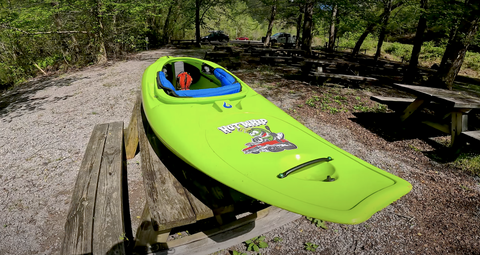
Half-slice kayaks are a type of whitewater kayak enjoying a recent resurgence in popularity. Half-slice kayaks take a kayak like a river runner, and turn it into a more playful kayak by cutting down the volume. A half-slice kayak has a similar bow to a river runner, but the stern is squashed to a low volume.
This allows the paddler to sink the stern under the water for moves such as squirts, splats, and pivots. Half-slice kayaks also have crisp rails for carving waves. They excel at allowing paddlers to perform maneuvers as they paddle downstream.
Both the Liquidlogic Hot Whip and Sweet Ride are prime examples of newer half-slice kayaks.
Crossover kayaks
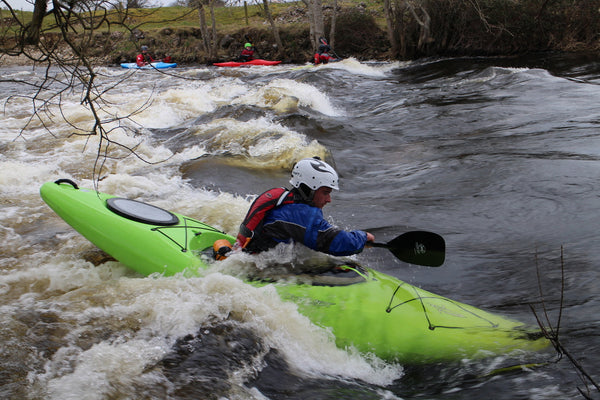
Crossover boats are long, high-volume boats that are stable and confidence-inspiring for beginners. They generally include a retractable skeg for smooth flatwater use, making them equally able to take you down a river or to a remote fishing or climbing spot.
The Dagger Katana and the Liquidlogic Remix XP10 are very popular crossover kayaks for flat water and running rapids.
Sit-on-top kayaks
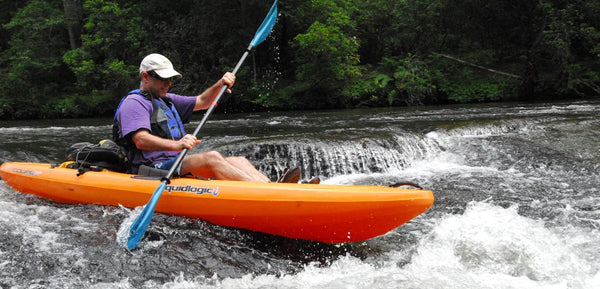
There are also sit-on-top kayaks designed for whitewater. Whitewater sit-on-tops are a great way to introduce someone to the sport without them being enclosed in a kayak cockpit. Rather than having to learn to roll, when a sit-on-top capsizes the paddler can just climb back on.
Sit-on-tops are best-suited to intermediate or easier whitewater, such as class II or class III. Not just any sit-on-top will work best. There are a few models built specifically for this use, which also include thigh straps to help paddlers stay in the boat and control it. Refer to the segment below for more info on how a whitewater kayak and recreational kayak differ.
The Liquidlogic Coupe XP kayak is a sit-on-top rated for Class II whitewater.
Types of whitewater
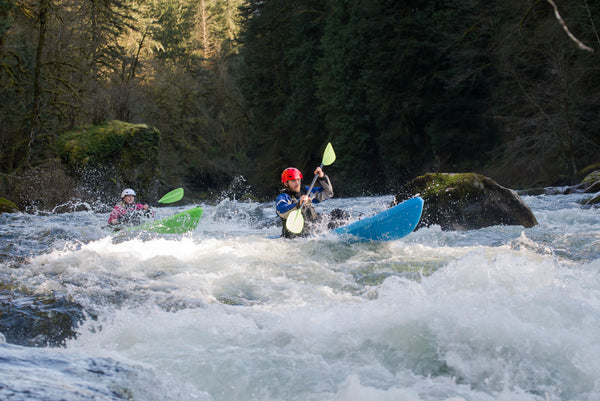
There are a good number of whitewater rivers in the Georgia, Tennessee, and Carolina quad state area. Rapids in these rivers are responsible for whitewater. They are areas of lower water levels that cause the waves to beat against the exposed rocks, which aerates the water with air bubbles and it makes for a fun ride. Water naturally flows downstream and the goal is to move with that current.
How are rapids classified?
The international rating scale of river difficulty by the non-profit organization, American Whitewater, provides a guide to classify rivers and rapids. This rating is based on the width of the water channel, size and strength of waves, degree of obstructions present, ease of swimming and self-rescue. These correlate to the level of skill and experience required for navigation. The scale features Roman Numerals I-VI; from easy to most difficult.
What are the implications of the classes of rapids?
The classification system of a river is a universal numerical rating system and a good guideline. However, it is important to always scout the entirety of any rapid that you want to run, even if you've been there before. We always recommended that you hire experienced guides or paddle with experienced kayakers that you can trust.
Experience, goals, and learning style
The first step to buying a kayak is determining your whitewater kayaking experience, goals and learning style. A paddler who is ready to get on the river every day of the week will be looking for a very different boat than someone who is looking to get out once or twice a month as they learn. A first time whitewater kayaker will need a much different boat from that of an experienced paddler.
Whitewater kayaking can be physically demanding and difficult. There is no sugarcoating the fact that kayaking can be a difficult sport to learn. The first few days in a boat can often be just as frustrating as they are rewarding. Choosing the right boat for you will help diminish the learning curve and frustration, making for a much more enjoyable experience on the water.
Consider what you want
- Some boats make starting out very difficult but at the same time teach you better technique and give you more room to advance.
- Other kayaks will make starting out easy - but as you progress, the more forgiving designs can prevent you from honing technique.
- If you are the kind of person who doesn’t want to flip over very often, starting out in the most stable design is a good idea.
- If you don't mind a steep learning curve involving swimming out of your kayak and rolling over often, starting out in a smaller and less stable kayak will lead to better technique in the long run and will help you progress to harder whitewater.
What kayak is best for me?
For the beginner paddler, we suggest a creek boat like the Pyranha Scorch or an all river boat like the Liquidlogic RMX. Both of these kayaks promote stability and let you enjoy paddling without too steep of a learning curve.
Other kayaks like the Liquidlogic Alpha and the Dagger Code are go-to options for beginners as well. They are stable, forgiving, and make paddling feel easier.
With half-slice boats becoming more popular, beginners are often choosing these kayaks because they are better for learning skills such as edge control and they remain a fun choice as kayakers progress to expert-level kayaking. Kayaks like the Dagger Rewind, Pyranha Ripper 2 and Liquidlogic Sweet Ride are great for both experienced paddlers experts and beginners alike.
While playboats aren’t a good choice for most casual kayakers, those who are willing to be patient and fall a lot before they succeed are rewarded with strong technical skills. The Dagger Nova and the Pyranha Ozone are good full slice boats for a highly motivated beginner looking to learn technical skills early on in their paddling. The Liquidlogic Hot Whip is a great half-slice option for those wanting to get into playboat tricks, but with a better downriver ride.
Other must have accessories and gear to get started
Whitewater kayakers need 5 essential pieces of gear to get on the river:
- Boat
- PFD (personal flotation device or lifejacket)
- Paddle
- Helmet
- Spray skirt
These 5 pieces of gear are the minimum you need to get out on the river.
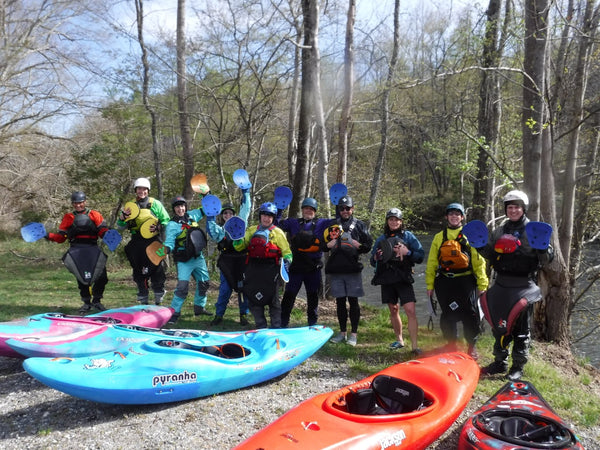
Additionally, a whistle, a knife, water shoes, and a dry top are essential for beginners who may spend some time in the water before they dial in their paddling. Learning swift water safety, and how to use a throw bag, carabiners, a Z drag system, pulleys, and other rescue gear can be vital as well.
We hope you found this introductory guide helpful. Feel free to give us a call or stop by the Festive Water shop to learn more about whitewater kayaking, or get get help picking out your first boat
References:
- https://coloradokayak.com/blogs/cks-blog/a-beginners-guide-to-getting-your-first-whitewater-kayak
- https://www.whitewaterguidebook.com/your-first-whitewater-kayak/
- https://paddlingmag.com/skills/strokes-techniques/how-to-edge-a-kayak/
- https://www.watersportswhiz.com/different-types-of-whitewater-kayaks/
- https://mhoadventures.com/white-water-rapids-classification/

